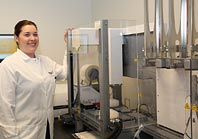Access Agilent eNewsletter, January 2015
>> Update My Profile | Subscribe to Access Agilent | Article Directory

Agilent Bravo Platform dramatically accelerates sample processing, providing reproducible results
By Kasia Proctor
Agilent Senior Product Manager, Automation Systems
Successful laboratories that deliver reliable, timely results are often rewarded with enormous increases in the number of samples to prepare. If your sample load is growing rapidly, you know that sample preparation steps such as pipetting into well-plates can become a large bottleneck in the process. Labs have found that the Agilent Bravo Automated Liquid Handling Platform provides the speed and reproducibility that are critical to their success with tremendous leaps in sample load. Two customer stories help to explain the benefits.
TGen Lab achieves a fast start with Agilent Bravo Platform
Like her colleagues at the Translational Genomics Research Institute in Scottsdale, Arizona, research associate Kristi Stephenson is driven by the need for speed. The Arizona-based nonprofit – known as TGen – performs genomics/disease research for cancer, neurological disorders, diabetes, multiple myeloma, and other diseases.
 Enlarge
Enlarge
Figure 1. Kristi Stephenson uses the Agilent Bravo Platform to process 1500 sequencing samples reproducibly.
“It says a lot about the Bravo Platform that we could come in pretty green and get it working to our liking pretty quickly.”
As a research associate, Stephenson’s job is to process samples for sequencing – a vital first step in the quest to understand the underlying causes of complex maladies.
“At TGen, we try to take the work we do in the lab as quickly and efficiently as possible to something that can be translated to benefit patients,” Stephenson says.
In fact, quickly moving discoveries “from bench to bedside” is the cornerstone of TGen’s charter, she says.
A big leap in sample volume – and in repeatability of results
Stephenson gets things off to a fast start with the help of the Agilent Bravo Automated Liquid Handling Platform. Less than a year ago, she was preparing samples manually, 20 to 30 at a time, and that was manageable, she says. But then TGen was awarded a large contract that involves samples from 1500 subjects.
“It was a big leap,” Stephenson says. “We wouldn’t have been able to do it without the Bravo.”
The transition was, by necessity, a quick one – and the Bravo Platform was soon up and running at full capacity – preparing 96 samples per batch.
Speed is not TGen’s only concern – and it is not the Bravo Platform’s only strength. Especially impressive, Stephenson says, is how the new system has improved reproducibility.
“We’ve seen this especially with the exome preps we’ve done on the machine. We are able to get the most reproducible results we’ve ever seen,” she says.

Figure 2. Yannick Lippi, the transcriptome facility’s operations manager, credits the Agilent Bravo Platform for a dramatic increase in sample throughput.
“The Bravo is for us a good platform – very rapid and precise and robust. It increased not only throughput but also reproducibility.”
Bravo Platform helps transcriptome lab meet growing demand
Preparation of samples for sequencing is just one area where the Bravo Platform excels. Sample processing for transcriptomics is another. Transcriptomics (expression profiling) can be very revealing. It can, for example, tell researchers whether a certain condition or treatment triggers a response from the subject’s immune system.
That is one of the many reasons scientists bring blood and tissue samples to the GeT-TRiX laboratory in Toulouse, France. They want to see which genes are switched on or off. They want to understand what biological processes are at work in their subjects.
GeT-TRiX, the transcriptome facility for France’s highly regarded National Institute for Agricultural Research, analyzes samples for both academic researchers and private laboratories.
“Demand has been growing rapidly,” says Yannick Lippi, the facility’s operations manager. “In 2011, the facility’s first year of activity, we analyzed fewer than 100 samples. Now we analyze around 1600 samples a year.”
“The questions we answer depend on the samples and the biological groups,” Lippi says. “Someone may bring us liver samples from healthy subjects and diabetic subjects, for example, so they want to know what genes are regulated between the two groups and what biological functions are involved in the treatment or the pathology.”
Increased throughput and reproducibility
Lippi and his colleagues at GeT-TRiX process samples using 384-well-plate qPCR (quantitative polymerase chain reaction) and Agilent Gene-Expression Microarrays. They increased productivity by adding the Agilent Bravo Automated Liquid Handling Platform.
“We have a lot of projects dealing with large amounts of samples, and we were having trouble keeping up with demand, but our throughput dramatically increased because of this solution,” Lippi says. “Prior to using the Bravo, we could process 48 samples in parallel. Now we can analyze 96 samples in parallel.”
“We have checked the data obtained with our pipeline, and it is comparable to data obtained with established microarray procedures and to RNA-seq data,” Lippi says.
This new pipeline – able to process up to 384 samples in a week – means the lab can respond to more researchers, giving them accurate data within short time constraints.
“The Bravo is for us a good platform – very rapid and precise and robust,” Lippi says. “It increased not only throughput but also reproducibility.”
If your sample volume has substantially increased – along with your need for reliable, reproducible sample processing – watch our video to see how the Agilent Bravo Automated Liquid Handling Platform can help you succeed with this challenge.
Then in the next issue of Access Agilent, learn how two university research labs use the Bravo Platform to accelerate their exciting work.
>> Update My Profile | Subscribe to Access Agilent | Article Directory
